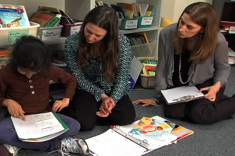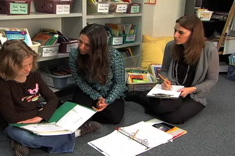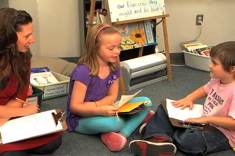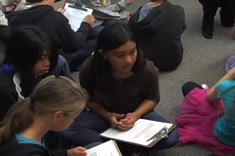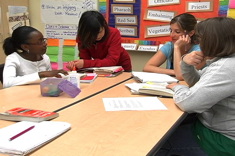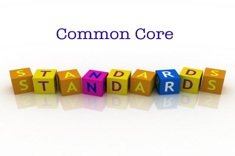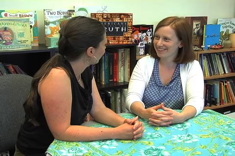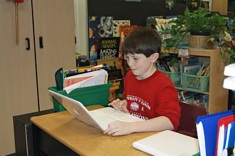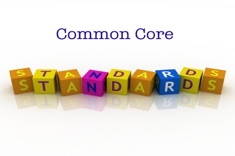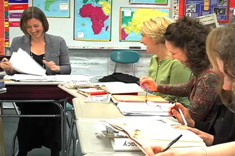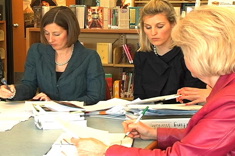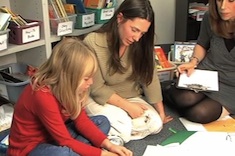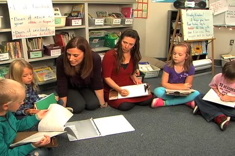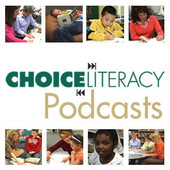Literacy Coaches
A simple question - who will coach the coaches? If you're a literacy coach, you already know there is no job more amazing or overwhelming in a school. Our Choice Literacy library includes a small sample of our resources for literacy coaches. If you work as a coach, you'll want a subscription that includes access to our Leaders Lounge, where there are over 900 resources for coaches, including study group protocols, videos of demonstration lessons, and guides for designing coaching cycles.
Latest Content
Professional Development Openers and Icebreakers (ROUND-UP)
This round-up includes suggestions for opening activities and icebreakers to energize your colleagues from Amanda Adrian, Aimee Buckner, Shari Frost, and Jennifer Jones.
Listen In: Writing in Math
Heather Rader confers with 2nd grader Maya about her math writing as Linda Karamatic listens in.
Listen In: Knowing When You’re Done
When is writing finished? Heather Rader confers with a second grader over that age-old question for writers as Linda Karamatic listens in.
Listen In: XBox Game Writing
Boys and their toys: Heather Rader confers with a second grader over his game writing while Linda Karamatic listens in.
Exit Slips Open Doors
Amanda Adrian explains how a simple professional development closure activity garnered many new invitations to classrooms.
Making Assumptions
The shift from teaching children to mentoring adults can be difficult for many educators. Ellie Gilbert chronicles the biggest assumptions that harm collaborative relationships with colleagues.
You’ve Got to Be Joking
A first-year teacher struggles to manage a class with boys who are cut-ups. From the lemons to lemonade department, Heather Rader helps him build on student strengths by developing a popular writing unit on joke writing.
The Sponge Summary Lesson Part 5
In this sequence of videos, Heather teaches a 4th grade class, using the analogy of a sponge to explain how summaries work. In this fifth video, Heather and students shift from “I do” to “we do” as students try test their summary writing skills with partners
Best Practices in Spelling Instruction
Heather Rader wades through the research to find the best practices in spelling instruction.
How Do We Structure Small Groups? (Part 3 of the Grouping Series)
Heather Rader synthesizes recommendations and provides examples of how grouping structures work in classrooms.
Listen In: Spelling Aids in the Writing Workshop
Many commercial aids are available to assist young writers. The challenge is choosing carefully, and integrating them into workshops in a way that doesn’t inhibit student fluency and risk-taking. In this video, Heather Rader confers with a second grader, demonstrating how to use a spelling log for high-frequency words.
Common Core Standards: Spreading the Word
Literacy leaders working in large districts face special challenges when implementing new programs. Suki Jones-Mozenter writes about the strategies being developed in one of the largest districts in the country.
Mentor Texts for Nonfiction Writing
Beth Lawson and Heather Rader meet to plan and share mentor texts for nonfiction writing in Beth’s fourth-grade classroom.
The Affect of Tech on Splrs
Heather Rader considers the cultural divide between teachers and students who are “screenagers” when it comes to texting. If u r getting LOLed out in ur classroom u might want 2 read this.
How Do We Know Small-Group Instruction is Effective?
Heather Rader considers how to assess the effectiveness of groups.
Can I Quote You on That?: Capturing Classroom Conversation
Here's a fun notetaking strategy to try. Ellie Gilbert records snippets of conversation from Katie Doherty's students, and then uses them in a debrief session to discuss student strengths, needs, and next steps.
Common Core Conversations: Using Evidence From Text
Amanda Adrian and Heather Rader explain how the standard for finding evidence in texts might change instruction.
Supporting New Teachers and Appreciating Their Gifts
Melanie Quinn thinks through the two common "phases" of early career teachers, and creates a checklist of guidance they will need from literacy leaders.
Planning for a Demonstration Lesson Part 1
In this first installment of a video series, Clare Landrigan takes a team of grades 3-5 teachers through the steps of planning for a demonstration lesson.
Planning for a Demonstration Lesson Part 2
In this second installment of a two-part video series, Clare Landrigan takes a team of grades 3-5 teachers through the steps of selecting a book for a demonstration lesson.
Building Community Protocols
Clare Landrigan and Tammy Mulligan share two of their favorite protocols for building community among educators.
On Their Own (Almost): Coaching and Classroom Demonstrations Mid-Year
In this video filmed in mid-January, Jennifer Allen observes new teacher Jessica, and explains how she struggles to redefine her role in the classroom.
Teaching and Assessing Persuasive Writing Skills
Heather Rader explores different ways into persuasive writing with teachers and students, highlighting the importance of helping students learn to cite and quote expert resources
Listen In: Magnifying a Moment in Writing
Sometimes using a prop can help young students understand a revision strategy. Heather Rader helps second-grader Sammi understand how to “magnify” a moment when revising her writing.
Evocative Coaching in Action (PODCAST)
In this podcast, Bob Tschannen-Moran uses the strategy of imaginative listening to process an unsettling interaction Heather Rader had with a colleague.
Voila! Best Writing and Entry Slips in Second Grade
The word voila in French literally means “see there.” Linda Karamatic puts time and reflection into creating a binder, or “voila book,” that will ease the bulging writing workshop folders and preserve the best of her second-grade students’ writing.
The Sponge Summary Lesson Part 1
In this sequence of videos, Heather teaches a fourth-grade class, using the analogy of a sponge to explain how summaries work. In this first video excerpt, Heather reviews the work the class has already done on understanding the attributes of good summaries.
The Sponge Summary Lesson Part 4
In this sequence of videos, Heather Rader teaches a 4th grade class, using the analogy of a sponge to explain how summaries work. In this fourth video, Heather and students discuss their summaries in progress
Common Core Conversations: Vocabulary
Amanda Adrian and Heather Rader explore connections between the Common Core and vocabulary instruction.
Katherine Casey on Coaching in Classrooms (PODCAST)
In this podcast, Katherine Casey shares her wisdom on classroom modeling for coaches that really works because both teacher and coach have clarity on the purpose and practice.
Browse Content By
Type
Category
- Assessment Tools
- Big Fresh Archives
- Booklists
- Choice Numeracy
- Classroom Design
- Common Core
- Community Building
- Conferring
- Content Literacy
- Digital Literacy
- English Language Learners
- Equity
- Family Relations
- Free Samples
- Guiding Groups
- Leadership
- Literacy Coaches
- Mentor Texts
- Minilessons
- New Teacher Mentors
- Podcasts
- Poetry
- Quote Collections
- Reading Strategies
- Self Care
- Struggling and Striving Learners
- Talking and Listening
- Teacher Study Groups
- Teaching Reading
- Teaching Writing
- Word Study and Vocabulary
Author
- Melissa Quimby
- Nawal Qarooni
- Gwen Blumberg
- Julie Cox
- The Lead Learners
- Hannah Tills
- Josie Stewart
- Ruth Metcalfe
- Mallory Messenger
- Becca Burk
- Jodie Bailey
- Vivian Chen
- Mary Brower
- Tiffany Abbott Fuller
- Stephanie Affinito
- Ruth Ayres
- Leigh Anne Eck
- Heather Fisher
- Shari Frost
- Julie Johnson
- Suzy Kaback
- Gigi McAllister
- Shirl McPhillips
- Melanie Meehan
- Cathy Mere
- Debbie Miller
- Tara Barnett and Kate Mills
- Tammy Mulligan
- Dana Murphy
- Bitsy Parks
- David Pittman
- Brenda Power
- Heather Rader
- Matt Renwick
- Mandy Robek
- Christy Rush-Levine
- Gretchen Schroeder
- Jen Schwanke
- Brian Sepe
- Katherine Sokolowski
- Stella Villalba
- Jennifer Vincent
Grade Level
Choice Literacy Membership
Articles
Get full access to all Choice Literacy article content
Videos
Get full access to all Choice Literacy video content
Courses
Access Choice Literacy course curriculum and training


